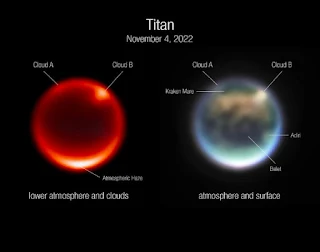Saturn's moon Titan:
Introduction
Saturn's moon Titan is one of the most interesting places in our solar system. It's the only place other than Earth where we've found evidence of stable bodies of liquid on the surface, and it's thought to be similar to our own planet in many ways. In this blog post, we'll explore some of the latest findings about Titan, including its potential habitability and the possibility that it could be home to life. We'll also discuss the challenges of exploring Titan, which is one of the most distant and hostile environments in our solar system.
The composition of Titan
Titan is mostly made of water ice and rocky material. The ice is thought to be a mix of frozen methane, ammonia, and ethane. The rocky material is believed to be made up of silicate rocks. Titan's interior is thought to be similar to Earth's, with a rocky core surrounded by a mantle of water ice.
Titan's atmosphere is much thicker than Earth's atmosphere, and it is mostly nitrogen with some methane and hydrogen. The atmospheric pressure at the surface is about 1.5 times that of Earth's atmosphere at sea level. Titan also has clouds and weather patterns, including rainfalls of methane and ethane.
The atmosphere of Titan:
The atmosphere of Titan is chief composed of nitrogen with a small amount of methane. The atmospheric pressure at the surface is 1.5 times greater than Earth's. The temperature on the surface averages around 94 K (-179.2 °C). Scientists believe that the atmosphere may be similar to what Earth's was before life began to form.
The surface of Titan:
Most of what is known about the surface of Titan comes from data collected by the Cassini-Huygens mission, which orbited Saturn and sent a lander to Titan between 2004 and 2017. The surface is mostly covered in ice and hydrocarbon lakes and seas. There is also evidence of volcanism, tectonic activity, and weathering.
The first detailed images of the surface were taken by the Huygens lander as it descended towards its landing site in 2005. The landscape was found to be very different from that of Earth, with no obvious signs of life or advanced civilizations. The terrain was found to be mostly smooth, with few impact craters. This suggested that the surface was young, possibly less than a billion years old.
The smoothness of the surface also suggested that there was some kind of global process at work on Titan. One possibility was that liquid methane or ethane rain had eroded the surface over time. Another possibility was that cryovolcanoes had erupted, spewing out water and ice onto the surface.
Further study of the data collected by Cassini has revealed even more details about the surface of Titan. The presence of lakes and seas suggests that there is a cycle of evaporation and precipitation on Titan. Tectonic activity has been observed, indicating that the interior is still active. And finally, weathering processes have been observed, suggesting that titan's atmosphere interacts with the surface to create complex organic
The Cassini-Huygens mission to Titan:
The Cassini-Huygens mission to Titan was a joint effort by NASA, the European Space Agency (ESA), and the Italian Space Agency (ASI) to send a spacecraft to study Saturn and its largest moon, Titan. The spacecraft was launched in 1997 and arrived at Saturn in 2004.
The Cassini spacecraft orbited Saturn for 13 years, studying the planet, its rings, and its moons. In 2005, the Huygens probe was released from the spacecraft and landed on Titan, becoming the first man-made object to land on a world in the outer solar system.
TheCassini-Huygens mission was an unprecedented undertaking that has yielded incredible insights into Saturn and its enigmatic moon Titan.
Conclusion
Saturn's moon Titan is an amazing place, and we are only just beginning to scratch the surface of its potential. With its unique atmosphere and interesting terrain, Titan is a great place to study for future missions to Mars and beyond. We hope that you have enjoyed learning about Titan and that you will continue to explore the solar system with us.






0 Comments